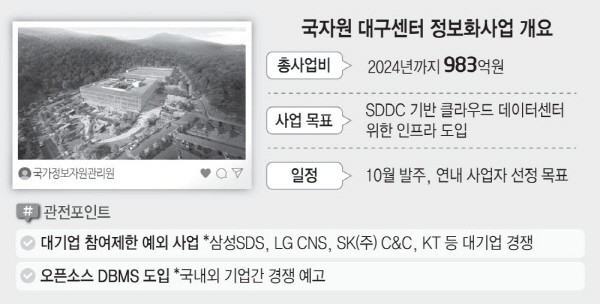Participated in briefing sessions for Samsung, LG, SK, KT, etc.
Profitability is key... Balancing business engagement
On the possibility of introducing an open source DBMS
Interest in Cubrid, EDB, Tma

The National Information Resources Service places an order for an informatization project to the Daegu Government Integrated Data Center (hereinafter referred to as the Daegu Center).
Since large companies are restricted from participating in the project, competition between large information technology (IT) service companies and telecommunication businesses is expected to be fierce as it is centered on building cloud infrastructure. Competition between open source database management system (DBMS) companies is also expected.
The National Information Resources Service will place an order for the informatization project to Daegu Center next month after reviewing the Korea Development Institute's (KDI) project cost and consulting the Ministry of Economy and Finance. The goal is to select a business operator within this year.
The total project cost is expected to reach 98.3 billion won by 2024, and with incidental expenses included it is expected to exceed 100 billion won.
The Daegu Center drew attention since the design stage, for its cloud and software-defined data center (SDDC). If the cloud is a technology that maximizes the efficiency of resources, Software-Defined Everything (SDx) technology enhances management convenience.
This is an opportunity for IT service companies to secure references for large-scale cloud/SDDC construction in the public sector. It can secure their lead in the public cloud market.
The overall business plan was shared at a briefing that was previously held in February of this year, with officials from Samsung SDS, LG CNS, SK C&C, and KT attending.
SK C&C was in charge of designing the first SDDS that was introduced in the Daegu Center as well as establishing the Cloud Development Verification Center. LG CNS was responsible for the second design for the Daegu Center.
KT strengthened its cloud business by splitting off KT Cloud. It recently expanded its system integration (SI) business, such as winning an order to build a defense integrated data center worth 160 billion won.
The key is profitability. The reason there have been a series of failed bids in large public informatization projects over the past two to three years is because secure profitability compared to the scope of the business has been difficult. In the Daegu Center project, profitability is also expected to be a determining factor in business participation.
Competition among open source DBMS companies is also a focal point to pay attention to. The government has taken the direction of selecting the Daegu Center DBMS as an open source. Although it is not forced to use Cubrid, Altibase, Goldilocks (SUNJESOFT), MariaDB, and PostgreSQL, they are a guiding character.
This is a flexibility and cost reduction measure in the cloud environment. As a result, Cubrid, Altibase, SUNJESOFT, MariaDB as well as EDB, INZENT, and TmaxSoft, are showing interest in participating in the project. They are also participating in the ongoing public cloud conversion project by the Ministry of the Interior and Safety.
“The Daegu Center is scheduled to continue its business after this year, so a soft landing through winning the project is important,” said Cubrid CEO Byung-ju Jung.
The National Information Resources Service promoted the Daegu Center design project in 2016, and in 2018, it carried out the pilot projects, including the Cloud Development Verification Center. The construction of the building was delayed for various reasons such as audits, and was completed in the first half of this year.
The Daegu Center first plans to relocate 40 institutions, including major government-affiliated organizations and public institutions, and the remaining 200 institutional systems by 2030.
By staff reporter Ho-cheon Ahn (hcan@etnews.com)